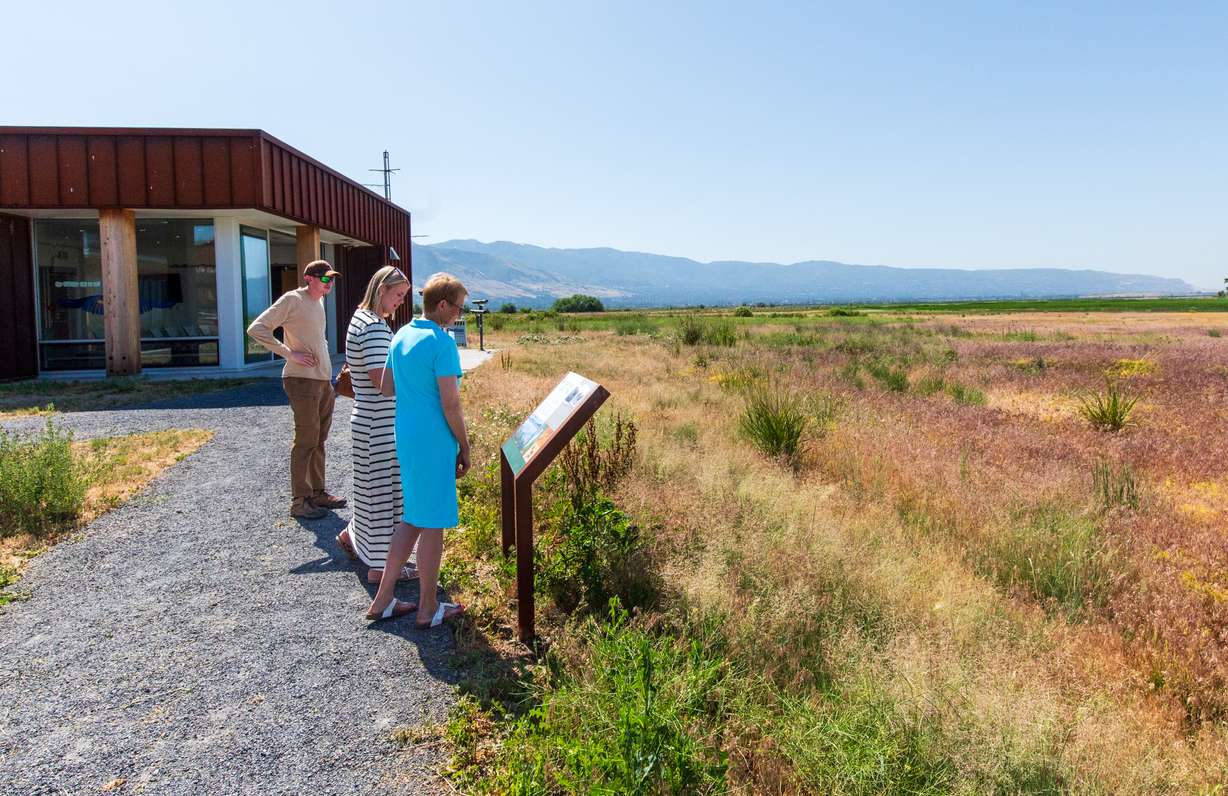- A new trail honors Robert Hasenyager, who protected Farmington Bay's natural beauty.
- The trail allows visitors to enjoy wildlife without needing a hunting or fishing license like other parts of the waterfowl management area.
FARMINGTON — Marlene Hasenyager feels her husband's presence whenever she stares out toward the flat, marshy openness that is Farmington Bay.
Aside from distant planes here or there, it's generally peaceful and quiet. It's a place where you can stand and watch scores of shorebirds, songbirds, nesting birds and raptors mill around the wetlands near Great Salt Lake's southeast shoreline.
"It's kind of my happy place," she says.
Robert "Bob" Hasenyager, who died in 2013 at the age of 61, was a long-time employee of the Utah Division of Wildlife Resources, and the creator of a foundation that sought to protect natural places like what is now the Farmington Bay Waterfowl Management Area.
He was her husband and a father, as well as a volunteer and a Farmington city councilman at one point.
He was also a lover of nature.
"The young men that he worked with in our neighborhood dubbed him 'Nature Boy' because he wanted everyone to love all things wild," Marlene Hasenyager said, as several swallows flew in murmuration behind her. "He wanted future generations to know that nature needs to be protected and appreciated."
Bob Hasenyager's legacy is now preserved through a new trail surrounding the George S. and Dolores Doré Eccles Wildlife Education Center, 1157 S. Waterfowl Way in Farmington, a facility that he advocated for before his death. The Utah Division of Wildlife Resources celebrated the completion of the Robert N. Hasenyager Great Salt Lake Nature Trail on Friday.
Most of the 1.6-mile loop was completed last year, but the division recently installed new signage to finish the project. It's topped with a viewing deck that allows birdwatchers from across the world a chance to enjoy the wildlife that Bob Hasenyager cared so deeply about.
"It's a really great place to go, where you can experience the wetlands up close and personal, and see all the different species," said Ashley Kijowski, manager of the Eccles Wildlife Education Center.
Preserving Farmington Bay
Bob Hasenyager's vision for Farmington Bay likely began nearly 50 years ago. He'd go duck hunting with his father every fall, and it's probably why he fell in love with the bay, Marlene Hasenyager surmises. It became a space where he hoped children could go to explore nature, not far from the Wasatch Front communities.
This led to him founding the Utah Wildlife In Need, which would include the Great Salt Lake Nature Center at Farmington Bay — a precursor to the Eccles Wildlife Education Center. It initially featured two portable classrooms and a small boardwalk, all of which were constructed by him with the help of high school students and state wildlife employees.
He later reached agreements with Davis and Weber school districts to bring students to the center on field trips, allowing them to learn all about the bay's delicate ecosystem. It also grew over time, although Hasenyager died before the current Eccles Wildlife Education Center was completed in 2018 on the location of the original classrooms.

Despite the growth that has taken place outside the waterfowl management area's boundaries in recent years, including the construction of new homes and the West Davis Corridor, Bob Hasenyager's dream has been realized. The education center and management area maintain the slice of nature that he spent decades championing.
"None of this nature preserve would be here if it weren't for the tenacious work and leadership of my very favorite person," Marlene Hasenyager said. "He died knowing he had left a place his neighbors, Farmington, school groups, birdwatchers and all people could come to hear the sound of birds, to smell the smells of the Great Salt Lake, and to enjoy this little piece of nature right in the heart of an urban area."
A renewed importance
The 18,000-acre management area is set apart to protect waterfowl, preserving a space for duck and goose hunters. It also holds great importance for all sorts of other bird species, drawing in a portion of the millions of migratory birds that utilize the Great Salt Lake each year.
While many come to hunt, thousands of people also come just to view the species found by the bay. The Robert N. Hasenyager Great Salt Lake Nature Trail aims to provide a place where they can do just that. Pelicans, ibis, egrets and great blue herons were some of the species that flew around the area as the state wildlife employees celebrated the trail on Friday.
"This truly is a jewel for the Division of Wildlife and the state of Utah, and it gets visited heavily," said Riley Peck, director of the Utah Division of Wildlife Resources.

The trail has increased visitation importance because it and the center are exempt from a new state law that requires visitors to own a state fishing or hunting license to enter other parts of the management area, along with similar management areas along the Wasatch Front. The Utah Wildlife Board finalized the rule last week.
It means that anyone without a license still has a place to view wildlife.
"Anyone can come here and walk our trails," Kijowski said. "I do think that's important because we can educate people who are coming from out of state, maybe people who come out here with a lot of family. They can still learn about how important the ecosystem is and still see all of those species because you're immersed in the wetlands."










